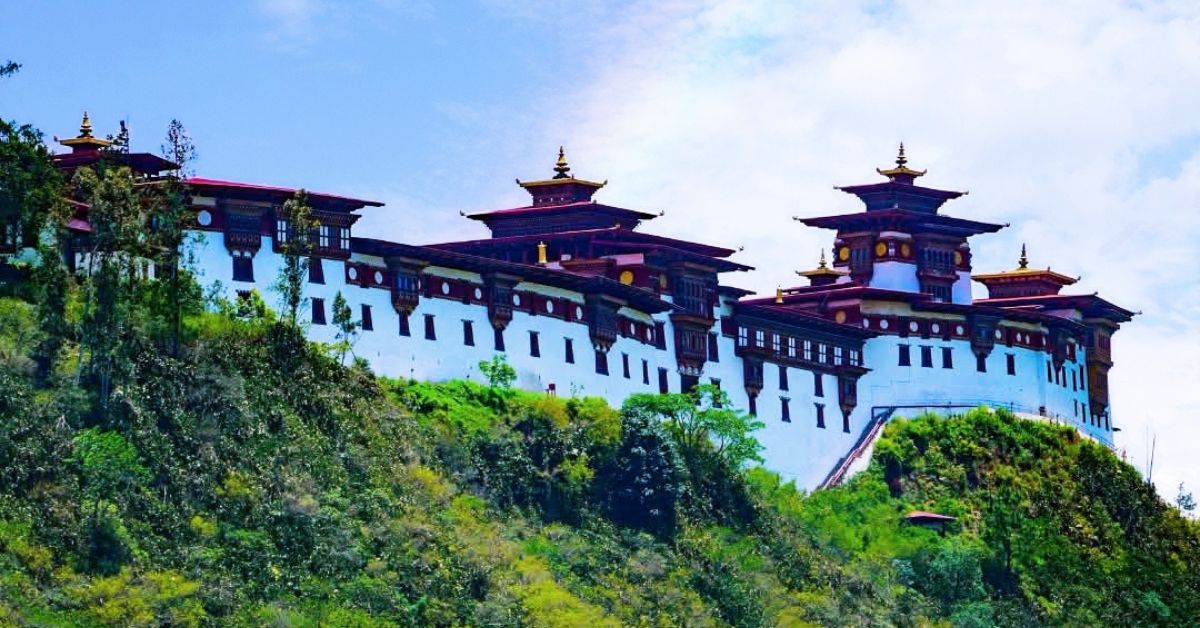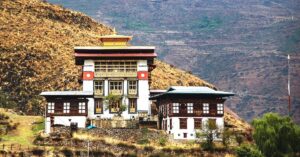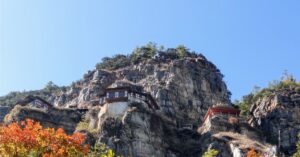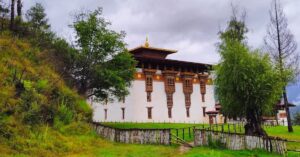Wangdue Phodrang Dzong, or the Druk Khamsum Wangdue Choeki Dzong, also known as Wangdue Dzong, is one of the 16 dzongs built by the Zhabdrung Ngawang Namgyal in Bhutan. It was built in 1638 to fulfill the prophecies of Pel Yeshey Gonpo and Lama Zhang on a hill that resembles a sleeping elephant.
Wangdue Dzong is situated at the confluence of two rivers, Dangchhu and Punatsangchhu, at an elevation of 1,273 meters in Wangdue Phodrang Dzongkhag. It is the third fortress built by Zhabdrung Rinpoche, after Simtokha Dzong and Punakha Dzong in the 17th century.
Sadly, the dzong was completely razed by a fire on June 24, 2012. Nevertheless, under the leadership of His Majesty King Jigme Khesar Namgyel Wangchuck, it was rebuilt and completed in 2022.
How to Reach Wangdue Phodrang Dzong
Wangdue Phodrang Dzong is located on a ridge between the confluence of two rivers. It’s about a 10-minute drive from the Bajo Town of Wangdue Phodrang. From Thimphu, it takes around 2 hours. But from the well-known Punakha Fort, it’s only a 30-minute drive.
History of Wangdue Phodrang Dzong
Wangdue Phodrang Dzong was built by the Zhabdrung Ngawang Namgyal in 1638.
According to history, Lama Zhang, who founded Zhemgang Dzong, made a prophecy upon viewing the area in the 12th century:
“On a Hill resembling the trunk of an elephant down below, at the confluence of two rivers, an emanation of the Glorious Naropa will build a palace in the future and promote happiness in the southern valley.”
Later, in the 17th century, when Zhabdrung was at Chimi Lhakhang, he had a dream. In the dream, an old man prophesied that Zhabdrung would unite the country if a fortress were built on a hill that resembled a sleeping elephant.
Zhabdrung, knowing that the old man was Pel Yeshey Goenpo, sent his attendant to find the location. The attendant saw four ravens circling above the ridge. When he reached the ridge, the ravens flew in four different directions. Upon returning to Chimi Lhakhang, he explained the signs, and Zhabdrung saw it as a good omen.
Another legend states that Zhabdrung met a boy named Wangdue while searching for a suitable location to build a dzong.
Zhabdrung started the foundation of Wangdue Dzong in 1638. Ponlop Nyama Kukye oversaw the construction of the fortress, which included a four-story Utse, for the next year and a half. It was completed in 1640 and was named Wangude Phodrang Dzong, the “Fortress of Glorious Unification” or “Wangdue’s Palace,” derived from the name of the boy, Wangdue.
Later, the Dzong was expanded, and the 4th Desi, Gyalsey Tenzin Rabgye, added a two-story Utse.
Also Read: Zhemgang Dzong, the Symbol of Unification of Khengrig Namsum
Significance of Wangdue Phodrang Dzong
Wangdue Phodrang Dzong is the third-oldest dzong built by Zhabdrung Rinpoche in Bhutan. It played an important role in Zhabdrung’s efforts to unify the country. The Dzong also served as an administrative center that managed trade routes between the eastern and western regions.
Also Read: Significance of Gasa Dzong, the Fortress that defended against Northern Invasions
Wangdue Phodrang Dzong Fire Destruction
Wangdue Dzong was destroyed by a large fire in 1837 and was later restored. However, on June 24, 2012, a fire destroyed the historic Wangdue Dzong. Only some of the sacred relics were rescued by volunteers and caretakers.
Wangdue Phodrang Dzong Reconstruction Project
Wangdue Phodrang Dzong Reconstruction Project started in 2014 at the command of His Majesty King Jigme Khesar Namgyel Wangchuck. His Majesty the King granted Nu 230 million, while the people of Bhutan contributed Nu 93.828 million. The government of India also supported the reconstruction project with Nu 1 billion.
The project reconstructed the three-storied Kuenrey, the four-storied central tower, and Shabkhor in the first and second courtyards, as well as Du-Khang. Additionally, the project built a 50-meter-long service tunnel in both courtyards.
Consecration of New Wangdue Phodrang Dzong
Druk Khamsum Wangdue Choeki Dzong, restored to its former glory, was consecrated on November 11, 2022. His Holiness the Je Khenpo led the ceremony and prayers, which started on November 9. His Majesty the King, His Majesty the Fourth King, Her Majesty the Gyaltsuen, their Royal Highnesses, and members of the Royal Family attended the consecration ceremony.
Description of New Wangdue Phodrang Dzong
The new Druk Khamsum Wangdue Choeki Phodrang once again crowns the sacred hill that resembles the trunk of a sleeping elephant. It features three gates and three courtyards. The first gate is the entrance to the dzong, the second gate leads to the inner sanctum, and the third gate provides access to the structure’s interior.
The new Dzong features 14 Lhakhangs. It also features an additional temple in the attic of the Kuenrey, which was previously used as a residence for Punakha monks whenever they visited Wangude Dzong. The Goenkhang has a figure of Mahakala carved on a stone slab brought from Druk Lhamoche in Ralung.
Also Read: Description of Paro Rinpung Dzong, the Fortress on a Heap of Jewels
Wangdue Cantilever Bridge
The original Wangude cantilever bridge was built in 1685 over the Punatsang Chhu. However, a massive flash flood washed away the entire bridge during the tenure of the 20th Wangzop Domchung. Wangzop Domchung began the reconstruction, but the river spirit interrupted the building process. To resolve this, Domchung organized a Tshechu to perform the Doley Raksha dance, which is believed to appease the river spirit. It is said that while the spirit was distracted by the festival, Domchung, along with several hundred men, went to the river and built the bridge. Later, the river spirit caused several flash floods to destroy it, but the foundation pillars had been cleverly designed to withstand the river’s force.
Wangdue Phodrang Tshechu Festival
Wangdue Phodrang Tshechu is a four-day annual festival held in the courtyard of Wangdue Dzong from the 8th to the 11th day of the 8th month of the Bhutanese calendar.
One of the highlights of Wangdue Tshechu is Dolungpai Raksha Chham, performed on the second day of the festival. It is believed to have been first organized by the 20th Wangzop Domchung to distract the river spirit, who was disrupting the reconstruction of Wangdue Bridge. Unlike the other mask dances, this mask dance is only performed by the lead dancer of Dolung Gonpa.
Also Read: The Festival of Tashichho Dzong, a Fortress at the Site of Blue Stone Dzong
Best Time to Visit Wangdue Phodrang Dzong
The best time to visit Wangdue Phodrang Dzong is during the spring (March to May) and autumn (September to November) seasons. If you want to attend the festival, time your trip during the annual Tshechu to immerse yourself in the vibrant celebrations of local culture and unique traditions with lively performances. You can visit the major pilgrimage sites of Wangdue Phodrang with the Bhutan Pilgrimage Package.
Conclusion
Wangdue Phodrang Dzong is a historic fortress built by Zhabdrung Ngawang Namgyel in 1638 on an elephant-like hill. The site was chosen after an auspicious omen of four ravens flying in four directions. Wangdue Phodrang Dzong served as the second capital of Bhutan in the past. Now, it serves as the administrative and religious center of Wangdue Phodrang District. After being destroyed by fire in 2012, it was rebuilt to its former glory in 2022.
Places to Explore in Wangdue Phodrang
Gangtey Monastery: It is the largest Nyingma center, noted for peling traditions and black-necked crane circumambulation, founded by the grandson of Pema Lingpa in Phobjikha Valley in 1613.
Baylangdra Ney: It is a sacred Himalayan cliff site where Guru Rinpoche subdued a local deity, concealed treasures, and meditated in Wangdue Phodrang.
Dechen Draphu: Dechen Draphu, “Cliff of Great Bliss,” is a sacred cliff where Phajo Drugom Zhigpo received a prophetic vision, marked by caves, relics, in Wangdue Sha Khotakha.
Temple of Sha Radap: It is a Rada Lhakhang dedicated to Sha Radap, the local guardian deity, where people pray for blessings, protection, and prosperity.
Khewang Lhakhang: It is a temple recognized for its historic murals, rituals, and architecture, dating back to the 15th century in Phobjikha Valley.
Enjoyed reading this blog?




